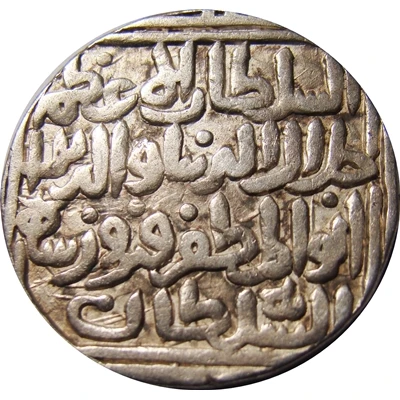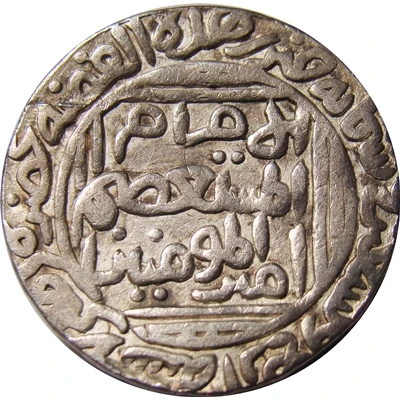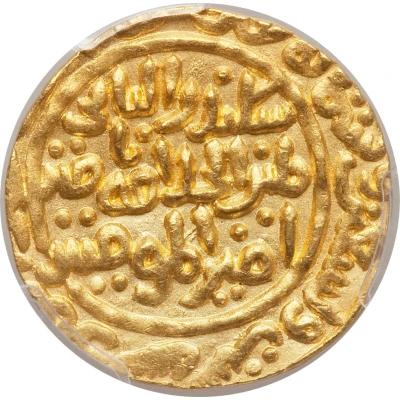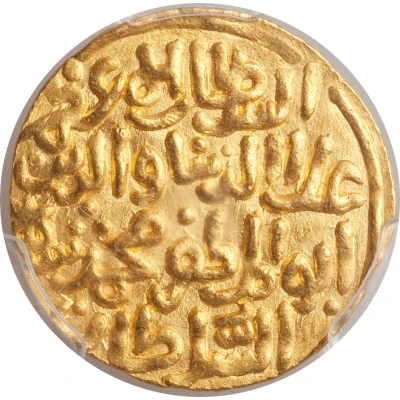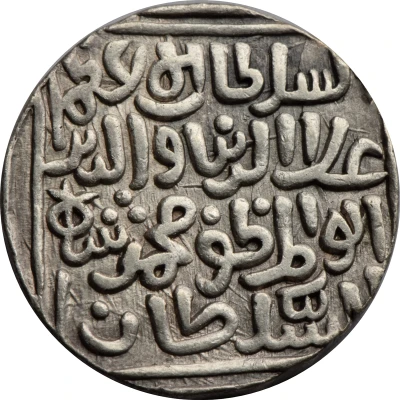
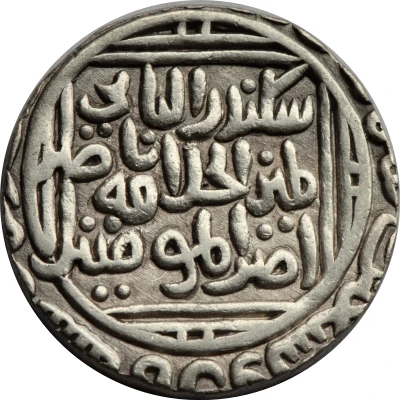

© Joseph Kunnappally
1 Tanka - Ala’ al-Din Muhammad Khilji ND
| Silver | 10.8 g | 28 mm |
| Issuer | Sultanate of Delhi (Indian Sultanates) |
|---|---|
| Sultan | Alauddin Khalji (1296-1316) |
| Type | Standard circulation coin |
| Years | 1296-1316 |
| Value | 1 Tanka |
| Currency | Tanka (1206-1526) |
| Composition | Silver |
| Weight | 10.8 g |
| Diameter | 28 mm |
| Thickness | 2.4 mm |
| Shape | Round (irregular) |
| Technique | Hammered |
| Demonetized | Yes |
| Updated | 2024-10-05 |
| Numista | N#42871 |
|---|---|
| Rarity index | 55% |
Reverse
Margin (starting at 12 o'clock, from right to left): "Zarb Hazihi Al-Fizzat Bi-Hazrat Dehli Fi Sanat (date)"
Legend in Persian: "Sikandar al-thani/ yamin al-khilafa/ nasir/ amir al-mu'minin"
Translation:
This silver coin was struck at hazrat (honorable) Delhi in Year (date)
Second Alexander
defender
right hand of the caliphate
commander of the faithful
Edge
Plain
Comment
date reads "theman wa tis'in (wa sitt mi'at)" which would be 698 AH.RULER: ALA AL DIN MUHAMMAD AH 695-715 / 19 July 1296–4 January 1316 AD
The Delhi Sultanate was a Muslim sultanate based mostly in Delhi that stretched over large parts of the Indian subcontinent for 320 years (1206–1526). Five dynasties ruled over the Delhi Sultanate sequentially: the Mamluk dynasty (1206–90), the Khalji dynasty (1290–1320), the Tughlaq dynasty (1320–1414), the Sayyid dynasty (1414–51), and the Lodi dynasty (1451–1526). The sultanate is noted for being one of the few states to repel an attack by the Mongol Empire, and enthroned one of the few female rulers in Islamic history, Razia Sultana, who reigned from 1236 to 1240. Qutb al-Din Aibak, a former Turkic Mamluk slave of Muhammad Ghori, was the first sultan of Delhi, and his Mamluk dynasty conquered large areas of northern India. Afterwards, the Khalji dynasty was also able to conquer most of central India, but both failed to conquer the whole of the Indian subcontinent. The sultanate reached the peak of its geographical reach during the Tughlaq dynasty, occupying most of the Indian subcontinent. This was followed by decline due to Hindu reconquest, states such as the Vijayanagara Empire asserting independence, and new Muslim sultanates such as the Bengal Sultanate breaking off. During and in the Delhi Sultanate, there was a synthesis of Indian civilization with that of Islamic civilization, and the further integration of the Indian subcontinent with a growing world system and wider international networks spanning large parts of Afro-Eurasia, which had a significant impact on Indian culture and society, as well as the wider world. The time of their rule included the earliest forms of Indo-Islamic architecture, increased growth rates in India's population and economy, and the emergence of the Hindi-Urdu language. The Delhi Sultanate was also responsible for repelling the Mongol Empire's potentially devastating invasions of India in the 13th and 14th centuries. However, the Delhi Sultanate also caused large scale destruction and desecration of temples in the Indian subcontinent. In 1526, the Sultanate was conquered and succeeded by the Mughal Empire.
Interesting fact
One interesting fact about the Ala’ al-Din Muhammad Khilji 1 Tanka coin is that it was issued during a time of great cultural and artistic achievement in the Sultanate of Delhi. The coin features intricate calligraphy and ornate designs, reflecting the rich artistic traditions of the era. Additionally, the use of silver in the coin's minting process speaks to the region's rich mineral resources and the value placed on precious metals at the time.
Price
| Date | Mintage | VG | F | VF | XF | AU | UNC |
|---|---|---|---|---|---|---|---|
| ND (1296-1316) | - | - | - | - | - | - |
Values in the table are based on evaluations by sales realized on Internet platforms. They serve as an indication only for 1 Tanka - Ala’ al-Din Muhammad Khilji ND (1296-1316) coin.
